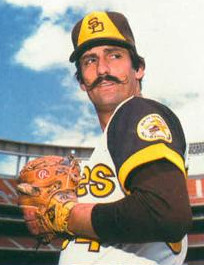
Roland Glen Fingers is an American former right-handed relief pitcher in Major League Baseball who played for three teams between 1968 and 1985. His effectiveness helped to redefine the value of relievers within baseball and to usher in the modern closer role. A seven-time All-Star, he led the major leagues in saves three times, and was named Rolaids Relief Man of the Year four times. He first gained prominence as a member of the Oakland Athletics championship teams of the early 1970s, when his flamboyant handlebar mustache made him perhaps the most identifiable member of The Mustache Gang, which led Oakland to become the only non-New York Yankees team ever to win three consecutive World Series titles. Fingers was named the Most Valuable Player of the 1974 World Series after earning a win in the opener and saves in the last three games to secure the title.
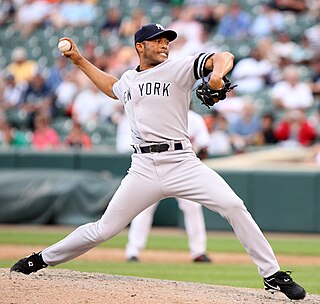
In baseball, a save is credited to a pitcher who finishes a game for the winning team under certain circumstances. A save can be earned by entering a game in which his team is leading by three or fewer runs and finishing the game by pitching at least one inning without losing the lead; entering the game with the tying run in the on-deck circle, at the plate or on the bases and finishing the game; or by pitching at least three innings in relief and finishing the game regardless of how many runs your team was winning by when entering the game. The number of saves or percentage of save opportunities successfully converted are oft-cited statistics of relief pitchers, particularly those in the closer role. The save statistic was created by journalist Jerome Holtzman in 1959 to "measure the effectiveness of relief pitchers" and was adopted as an official Major League Baseball (MLB) statistic in 1969. The save has been retroactively tabulated for pitchers before that date. Mariano Rivera is MLB's all-time leader in regular-season saves with 652, while Francisco Rodríguez earned the most saves in a single season with 62 in 2008.

In baseball, the pitcher is the player who throws ("pitches") the baseball from the pitcher's mound toward the catcher to begin each play, with the goal of retiring a batter, who attempts to either make contact with the pitched ball or draw a walk. In the numbering system used to record defensive plays, the pitcher is assigned the number 1. The pitcher is often considered the most important player on the defensive side of the game, and as such is situated at the right end of the defensive spectrum. There are many different types of pitchers, such as the starting pitcher, relief pitcher, middle reliever, lefty specialist, setup man, and the closer.

In baseball, a starting pitcher or starter is the first pitcher in the game for each team. A pitcher is credited with a game started if they throw the first pitch to the opponent's first batter of a game. Starting pitchers are expected to pitch for a significant portion of the game, although their ability to do this depends on many factors, including effectiveness, stamina, health, and strategy.

In baseball and softball, a relief pitcher or reliever is a pitcher who pitches in the game after the starting pitcher or another relief pitcher has been removed from the game due to fatigue, injury, ineffectiveness, ejection, high pitch count, or for other strategic reasons, such as inclement weather delays or pinch hitter substitutions. Relief pitchers are further divided informally into various roles, such as closers, setup men, middle relief pitchers, left/right-handed specialists, and long relievers. Whereas starting pitchers usually throw so many pitches in a single game that they must rest several days before pitching in another, relief pitchers are expected to be more flexible and typically pitch in more games with a shorter time period between pitching appearances but with fewer innings pitched per appearance. A team's staff of relievers is normally referred to metonymically as a team's bullpen, which refers to the area where the relievers sit during games, and where they warm-up prior to entering the game.
In baseball, a middle reliever, or middle relief pitcher, is a relief pitcher who typically pitches during the fifth, sixth, and seventh innings of a standard baseball game. In leagues with no designated hitter, such as in the National League before 2022 and the Japanese Central League, a middle reliever often comes in after the starting pitcher has been pulled in favor of a pinch hitter. Middle-relief pitchers are usually tasked to pitch one, two, or three innings. Several factors determine this, such as who’s winning, the score, eligible bullpen pitchers remaining, the importance of the current game, etc. After the middle relief pitcher has completed his portion, they are normally replaced in later innings by a left/right-handed specialist, setup pitcher, and/or lastly a closer. When they’re replaced, it is partly due to deprivation of stamina and/or effectiveness but also characteristics, such as pitch arsenal, speed of pitches, which arm they throw with, and who’s up to bat next for the opposing team. Middle relievers may pitch in these later innings, especially during games tied or close in score.
In baseball statistics, pitch count is the number of pitches thrown by a pitcher in a game.
A swingman is an athlete capable of playing multiple positions in their sport.

Richard William Tidrow was an American professional baseball pitcher and the senior vice president of player personnel and senior advisor to the general manager for the San Francisco Giants of Major League Baseball (MLB).

Robert Scot Shields is an American former professional baseball relief pitcher. He played his entire baseball career with the Los Angeles Angels of Anaheim of Major League Baseball (MLB). He was the last member of the Anaheim Angels' 2002 World Series Championship team remaining on the team's roster when he announced his retirement in 2011.

In baseball, the lefty-righty switch is a maneuver by which a player who may be at a disadvantage against an opponent of a certain handedness is replaced by a substitute who is better suited for the situation.

Kevin Ray Tapani is an American former Major League Baseball pitcher who played for the New York Mets, Minnesota Twins, Los Angeles Dodgers, Chicago White Sox, and Chicago Cubs from 1989 to 2001.

Stephen Joseph Gromek was an American right-handed pitcher in Major League Baseball who played for 17 seasons in the American League with the Cleveland Indians and Detroit Tigers. In 447 career games, Gromek pitched 2,064+2⁄3 innings and posted a win–loss record of 123–108 with 92 complete games, 17 shutouts, and a 3.41 earned run average (ERA).
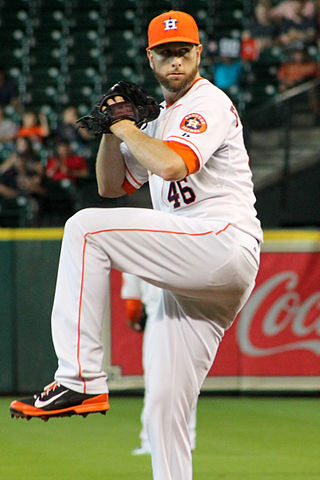
Scott Wynne Feldman is an American former professional baseball pitcher. He played in Major League Baseball (MLB) for the Texas Rangers, Chicago Cubs, Baltimore Orioles, Houston Astros, Toronto Blue Jays, and Cincinnati Reds.
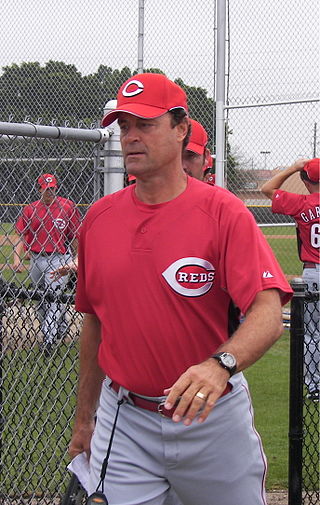
Ted Henry Power is a former Major League Baseball (MLB) pitcher and a minor league baseball coach. During a 13-year career in the major leagues, he pitched for the Los Angeles Dodgers (1981–1982), Cincinnati Reds, Kansas City Royals (1988), Detroit Tigers (1988), St. Louis Cardinals (1989), Pittsburgh Pirates (1990), Cleveland Indians (1992–93), and the Seattle Mariners (1993).

In baseball, a closing pitcher, more frequently referred to as a closer, is a relief pitcher who specializes in getting the final outs in a close game when his team is leading. The role is often assigned to a team's best reliever. Before the 1990s, pitchers in similar roles were referred to as a fireman, short reliever, and stopper. A small number of closers have won the Cy Young Award. Eight closers have been inducted into the Baseball Hall of Fame: Dennis Eckersley, Rollie Fingers, Goose Gossage, Trevor Hoffman, Mariano Rivera, Lee Smith, Bruce Sutter and Hoyt Wilhelm.

Shim Soo-chang is a South Korean relief pitcher for the Hanwha Eagles of the KBO League. He bats and throws right-handed.

In baseball statistics, earned run average (ERA) is the average of earned runs allowed by a pitcher per nine innings pitched. It is determined by dividing the number of earned runs allowed by the number of innings pitched and multiplying by nine. Thus, a lower ERA is better. Runs resulting from passed balls, defensive errors, and runners placed on base at the start of extra innings are recorded as unearned runs and omitted from ERA calculations.

Joseph William Kelly Jr. is an American professional baseball pitcher who is a free agent. He has played in Major League Baseball (MLB). He has previously played in MLB for the St. Louis Cardinals, Boston Red Sox, Los Angeles Dodgers and Chicago White Sox. He played college baseball for the UC Riverside Highlanders. He has served as both a starter and a reliever. The Cardinals drafted Kelly in the third round of the 2009 MLB draft. Listed at 6 feet 1 inch (1.85 m) and 190 pounds (86 kg), Kelly throws and bats right-handed. He won the World Series in 2018 and 2020 with the Red Sox and Dodgers, respectively.
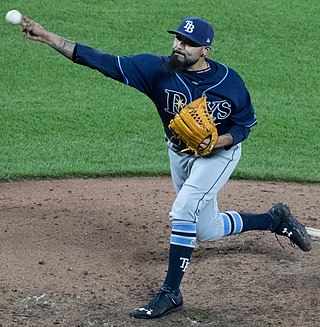
In baseball, an opening pitcher, more frequently referred to as an opener, is a pitcher who specializes in getting the first outs in a game, before being replaced by a long reliever or a pitcher who would typically be a starting pitcher. The name "opener" is a reference to the more established term "closer," which refers to a relief pitcher who typically works the final inning of a winning game. Like closers, openers are usually relief pitchers.

















